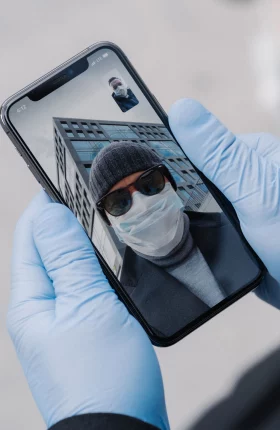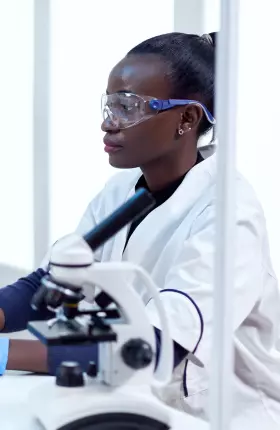This is the second in a series of articles on the role of testing in combating the COVID-19 outbreak. It examines the US’s current ability to diagnose the disease and what the rapid scaling up of its testing capability means for the health care system, public health officials, and business.
The ability to test for COVID-19 is ramping up fast in the US. More than 200 tests of multiple types are now available globally, from a range of manufacturers, and more are on the way. Diagnostic companies and molecular labs are working around the clock to deploy accurate, timely, at-scale testing to hospitals treating COVID-19 patients. Although real challenges—including high-profile backlogs at reference labs and shortages of sample collection kits and reagents—remain, the progress that manufacturers and labs have made in the past week in scaling up COVID-19 testing capacity is encouraging.
With proliferation comes complexity, however, and understanding how each new test works, what it can and cannot do, and when and under what circumstances it should be used is critical to avoiding confusion and misapplication. The choices that governments, health systems, businesses, and others make in deploying specific diagnostics can shape and inform both treatment and the allocation of vital but limited resources.
Here’s our assessment of the current state of testing for the disease in the US and the opportunities and pitfalls that lie ahead.
Tests Proliferate Rapidly
The last week of March witnessed an unprecedented expansion in the number and types of diagnostic tests available in the US and globally, including the arrival of some notable rapid near-patient and point-of-care (POC) tests, which have created much excitement. Let’s start with a summary of the current types of test available. As we wrote in our first article, no single diagnostic test is perfect for all uses. Tradeoffs are necessary across four key dimensions: speed, accuracy, sample type, and cost and pricing.
Tradeoffs are necessary across four key dimensions: speed, accuracy, sample type, and cost and pricing.
Individual Lab Developed Tests (LDTs). Primarily developed and deployed at large academic medical centers and reference laboratories, LDTs continue to provide much-needed local testing capacity to detect the viral genome in patients. They are difficult to scale up, and response times vary dramatically (onsite hospital labs typically provide same-day turnaround; national reference labs’ turnaround may range from two to five days, depending on logistics).
In-Vitro Diagnostic (IVD) Molecular Tests. These high-throughput tests, developed by the CDC, Roche, Hologic, ThermoFisher, and others, and deployed in hospitals and reference labs, are the most accurate platforms. They leverage the global installed base of instruments to detect the viral genome in patients, and they are easier to scale than LDTs (IVD platforms can process approximately 500 to 1,000 samples per day). Because they tend to be centralized in larger laboratories and operate with their own logistics and batching workflows, however, they commonly have sample-to-answer turnaround times of two days or more.
Molecular Rapid Near-Patient IVD Tests. These automated near-patient molecular IVD tests, such as Cepheid GeneXpresst, provide detection capabilities similar to those of high-throughput IVD platforms, but they produce results much faster—typically within 45 minutes of receiving a sample. On the other hand, sample throughput is much lower, at about 15 to 25 samples per day per unit. In light of their accuracy and relative portability, they are ideal for time-sensitive screening and diagnosis applications in clinical or field-based settings.
Point-of-Care 5- to 15-Minute Molecular Tests. Lightweight platforms, such as the Abbott ID Now, can detect the viral genome in mobile settings where sample-to-answer speed matters. These tests typically have a lower level of accuracy than high-throughput and near-patient platforms do, so they are most suitable in settings where the consequences of false negatives or false positives are less significant, or where an orthogonal approach can quickly confirm their results.
Serology (Blood) 5- to 10-Minute Tests. Tests similar to the Cellex-developed COVID-19 test, which has received FDA EUA approval, or to the recently launched Henry Schein COVID-19 serology test can detect biological immune response (IgG/IgM) to the COVID-19 virus at 7 to 14 days after infection. Early clinical evidence suggests that patients who have these antibodies show some degree of immunity to the virus. The FDA recently changed its guidance to allow the launch of serology tests without approvals, so long as they are not used as the sole diagnostic. As a result, several tests developed in the US and globally will launch soon. Accuracy in this category varies widely. The serology tests deemed most accurate will play an important role in gauging immunity in people with prior infections. This will help the US workforce resume work when it safely can and will help researchers understand the scope of the outbreak retroactively. Serology tests may also have applications in screening and confirmation when therapies and vaccines become available. Automated platforms for serology testing, such as the recently announced assay in development for the Beckman Coulter Access platform, will be necessary to scale up serology testing for broad use.
The serology tests deemed most accurate will play an important role in gauging immunity in people with prior infections.
Testing Tradeoffs
Given the number and range of tests that are receiving rapid regulatory clearance globally (or launching with no approvals required), the task of matching the appropriate type of test to a particular use becomes a significant challenge. For purposes of diagnosis and triage—where accuracy, rapid turnaround time, and throughput are key considerations—the most appropriate tests are IVD molecular tests, since they run on the installed instrument base in hospitals' molecular labs and likely offer the best balance of throughput, speed, and accuracy in an acute-care setting. Going forward, tests that include diagnosis for COVID-19 along with testing for 20 or more other respiratory infections will probably launch. Rapid, near-patient tests offer fast results (45 minutes to 2 hours from sample to answer) and simplified workflow; their disadvantages are higher cost and lower throughput. Rapid point-of-care tests are even faster—as well as being more portable and less expensive—but they are less sensitive and may deliver more false negatives. Even so, they might be the best option in primary-care, urgent-care, and field or retail clinic settings.
For population health monitoring, the most appropriate tests will likely be IVD molecular tests and immunoassays because this level of testing requires highly scalable platforms as well as high sensitivity and specificity. The drawback here is that turnaround times can range from one to five days, depending on the backlog of tests awaiting processing, and patients must self-quarantine until the results come back.
Immunity diagnosis, which will become important once the initial wave of infections has passed, can use serological tests. Depending on the specific use case, critical factors include speed, scalability, sensitivity, and specificity. Today, serological tests still have three key limitations. First, the extent and duration of immunity that antibodies provide to patients are as yet unknown. Second, the FDA is allowing serological tests to launch with limited regulatory oversight. Third, the performance levels and accuracy of individual tests have not been well established—and reinforcing this uncertainty, China’s National Medical Products Administration has recently slowed the export of serology tests.
For population health monitoring, the most appropriate tests will likely be IVD molecular tests and immunoassays.
Despite the many tests available globally, scaling up testing capacity to required levels in locations that are beset by the most critical supply-demand imbalances remains a major challenge. In the near term, IVD testing capacity is limited to the installed base of instrument platforms in hospitals and labs. A new molecular instrument takes about 30 days to manufacture and ship, and it must then be installed by trained technicians, who typically need to travel to the installation site. We estimate that the current installed base of molecular IVD diagnosis capacity in the US is about 500,000 to 600,000 tests a day. The number of tests actually being conducted was probably around 130,000 to 160,000 a day in early April.
Several factors continue to limit scaling, including imbalances in the availability of end-to-end sample collection, sample processing, and test kits.
Several factors continue to limit scaling, including imbalances in the availability of end-to-end sample collection, sample processing, and test kits. Diagnostic manufacturers are working tirelessly to scale quickly, but even the early-approved tests are constrained by the practical requirements for turning labs on in the field. Many OEM IVD test kit manufacturers can scale and supply chemical test kits and cartridges, but they do not control the end-to-end supply chain (and in some cases they directly compete for inputs) for the swab kits, transport media, sample preparation reagents, and other critical components in the sample-to-answer workflow.
No test is perfect. With the rapid increase in availability of so many different tests, hospital administrators and government officials need to consider several variables in determining their diagnostic testing needs. Three are particularly important:
- The Specific Purpose of the Test. For example, is the goal to detect the presence of the virus in order to guide triage and therapy, or is it to identify the presence of antibodies that may confer at least some post-infection immunity?
- Sample-to-Answer Speed. The time required to collect and test samples and to interpret and communicate results can mean the difference between immediate diagnosis of a patient in the emergency room and the possibility that the patient, if infected, may spread the virus in public for the next three days.
- Accuracy. The sensitivity and specificity of a specific diagnostic test can play a major role in determining when and where to deploy it. Sensitivity is the extent to which the test does not overlook true positives (meaning fewer false negatives). Relying on tests with a significant false negative rate can result in allowing virus-shedding carriers to expose more people in the community to COVID-19. Specificity is the extent to which the actual test accurately determines negatives (meaning fewer false positives). Erroneous identification of symptomatic patients with false positives could lead to their being directed to already overwhelmed treatment systems, exposing vulnerable patients to the virus rather than treating them in safer settings for their underlying non-COVID conditions.
Setting Priorities
COVID-19 is far from uniform in its spread and impact. Each state, locality, and health system has its own set of circumstances and needs, which can range from mild to severe. Uncertainty is a complicating factor. Speedy and effective diagnosis is necessary everywhere, but given the national scale of the crisis, local officials and health system executives should consider their individual needs and priorities carefully.
In dealing with crisis volume, the priority is to enable accurate and timely diagnostic testing at emergency room facilities where symptomatic patients are present.
For cities, states, and health systems that are dealing with or approaching crisis volume, the priority is to enable accurate and timely diagnostic testing at acute-care hospitals and emergency room facilities where symptomatic patients are present. The following actions are urgent:
- Activate and scale the health systems' molecular labs (if available) for COVID-19 testing; use all available molecular IVD testing platforms in the facility, emphasizing rapid near-patient molecular diagnostic testing to guide triage and to isolate and begin treating COVID-19-infected patients quickly.
- Make an inventory of the fastest and most accurate platforms, such as near-patient platforms, and local on-premises platforms.
- Establish alternative backup testing capacity with nearby local partner sites or reference labs for additional molecular lab capacity.
- In keeping with FDA guidelines, leverage in-hospital self-sampling collection with oversight from qualified medical professionals. The combination of self-sampling and rapid, accurate diagnosis could reduce the consumption of resources—including personnel time and protective equipment requirements—at hospitals, but the FDA has yet to approve any tests kits that permit consumers to collect their own samples at home.
- Begin active procurement and stocking to scale of test kits and of required, mission-critical consumables, including sample collection kits and swabs, transport media, sample preparation reagents, plastic wells, and other essential components in the sample-to-answer workflow. Coordinate the supply across local systems to share resources in catchment areas.
- Establish rotation plans to protect lab technicians from infection. Rotate A/B shifts to prevent infection in the entire team. To prepare for necessary surges in capacity, develop backup plans to augment testing technicians with personnel from local medical schools and alumni or retirees who have experience operating technical equipment.
- Establish reliable diagnostic procedures for hospital discharge, leveraging both molecular testing and diagnostic imaging.
- Look to scale reasonably accurate serology testing if the science confirms that biologically recovered patients with antibodies have gained immunity from the virus. Having this testing in place will eventually be critical to clearing infected healthcare professionals and first responders to return to work.
Mobile testing sites must include processes for addressing issues such as basic labeling and billing to help labs avoid receiving incompletely identified specimens.
Communities where the epidemic has not yet reached crisis levels should establish large-scale, easy-to-access screening and triage for patients who meet checklist screening criteria, such as having been in contact with known carriers or exhibiting mild or early symptoms of the disease. Here the priority should be to establish sample collection and testing sites as alternatives to hospital emergency rooms for patients who pass prerequisite screening (in the form of a checklist at an in-person site, or via telehealth screen) or who show mild or early symptoms. Local partners such as shopping centers, urgent-care centers, and media outlets can help with logistics and communications regarding the availability and criteria for visiting alternative testing sites. It is important to ensure that mobile testing sites include processes for addressing issues such as basic labeling and billing to help labs avoid receiving large volumes of specimens that lack names, insurance information, and doctor information.
Other communities should aggressively focus on avoidance and containment, while using the present to plan for scaling up their response if this becomes necessary. Relevant measures include social distancing (as prescribed by state and local governments), effective quarantining of suspected and confirmed positive patients, robust contact tracing, and accurate and timely local testing for diagnosis and triage of suspected symptomatic cases. These communities may also consider establishing routine local surveillance testing, until federal or central testing is put in place, to monitor and proactively contain possible outbreaks.
Disclaimer
The situation surrounding COVID-19 is dynamic and rapidly evolving on a daily basis. Although we have taken great care prior to producing this article, it represents BCG’s general view at a particular point in time. This article is not intended to: (i) constitute medical, legal, or safety advice, nor be a substitute for the same; nor (ii) be seen as a formal endorsement or recommendation of a particular response. As such, you are advised to make your own continued assessments as to the appropriate course of action to take, using this article as general guidance only. Please carefully consider local laws and guidance in your area, particularly the most recent advice issued by your local (and national) health authorities, before making any decision.












